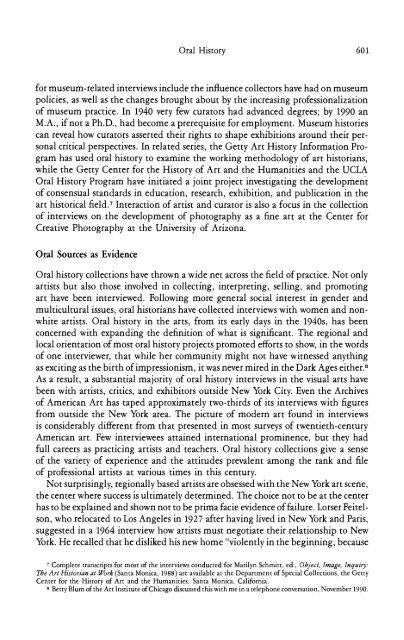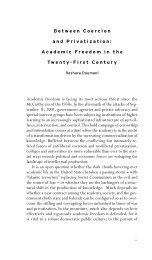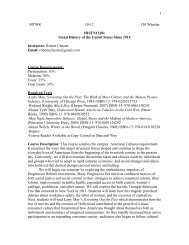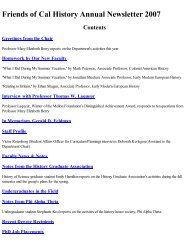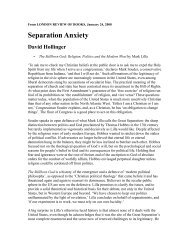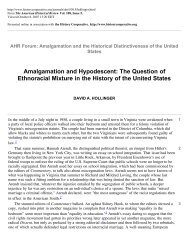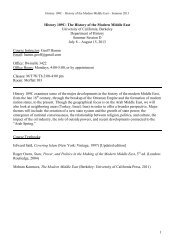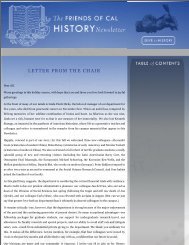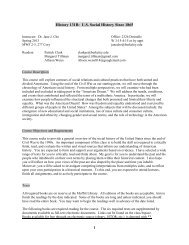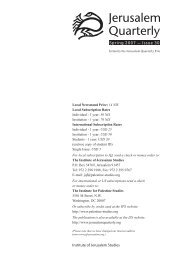600 The Journal of American <strong>History</strong>September 1991search projects. An immediate result of <strong>the</strong> conference was a project that collectedmore than three hundred <strong>in</strong>terviews on New Deal federal arts programs. Later archivesundertak<strong>in</strong>gs, funded by grants from state arts councils, have exam<strong>in</strong>ed regionaldevelopments <strong>in</strong> American art. Recent projects have recorded <strong>the</strong> experiencesof women <strong>and</strong> nonwhite artists. The archives' most recent project focuses on artists<strong>in</strong> midcareer.4Strong regionally focused collections can be found at California State University,Long Beach; Claremont Graduate School; Columbia University; <strong>the</strong> Maryl<strong>and</strong> HistoricalSociety; <strong>the</strong> Berkeley <strong>and</strong> Los Angeles campuses of <strong>the</strong> University of California;<strong>and</strong> <strong>the</strong> University of Wash<strong>in</strong>gton.5 The largest compilation of <strong>in</strong>terviews withAfrican-American artists is at <strong>the</strong> Hatch-Billops Collection <strong>in</strong> New York City. TheChicago Historical Society <strong>and</strong> <strong>the</strong> Chicago office of <strong>the</strong> Archives of American <strong>Art</strong>,housed at <strong>and</strong> staffed by <strong>the</strong> <strong>Art</strong> Institute of Chicago, have focused on <strong>in</strong>terview<strong>in</strong>gChicago's black artists, with emphasis on <strong>the</strong> <strong>in</strong>fluential social realist school thatflourished <strong>in</strong> that city's black community <strong>in</strong> <strong>the</strong> 1930s <strong>and</strong> 1940s. The <strong>Oral</strong> <strong>History</strong>Program at <strong>the</strong> University of California, Los Angeles (UCLA), recently began a serieson African-American artists <strong>and</strong> gallery owners after not<strong>in</strong>g that <strong>the</strong> black contributionto California's culturalife was virtually ignored <strong>in</strong> <strong>the</strong> numerous <strong>and</strong> extensivecollections deal<strong>in</strong>g with <strong>the</strong> state's art. The sou<strong>the</strong>rn California office of <strong>the</strong> Archivesof American <strong>Art</strong> has ongo<strong>in</strong>g projects <strong>in</strong>terview<strong>in</strong>g Lat<strong>in</strong>o artists <strong>and</strong> key figures<strong>in</strong> <strong>the</strong> development of <strong>the</strong> women's art movement <strong>in</strong> <strong>the</strong> 1970s. Interviews at <strong>the</strong>Hubbell Trad<strong>in</strong>g Post, Ganado, Arizona, are probably <strong>the</strong> s<strong>in</strong>gle largest collection<strong>in</strong> <strong>the</strong> <strong>United</strong> <strong>States</strong> relat<strong>in</strong>g to native American arts. The Hubbell <strong>in</strong>terviews focuson Navaho weav<strong>in</strong>g <strong>and</strong> o<strong>the</strong>r crafts, <strong>the</strong> <strong>in</strong>fluences an exp<strong>and</strong><strong>in</strong>g market had ondesign <strong>and</strong> production techniques, <strong>and</strong> <strong>the</strong> <strong>in</strong>teraction of Navaho <strong>and</strong> European-American artists who have settled <strong>in</strong> Arizona.The National Gallery of <strong>Art</strong> <strong>and</strong> <strong>the</strong> Museum of <strong>Modern</strong> <strong>Art</strong> have begun oralhistory projects to documen <strong>the</strong>ir <strong>in</strong>stitutional histories.6 These efforts deepen <strong>the</strong>historical record by add<strong>in</strong>g <strong>in</strong>formation on debates <strong>and</strong> compromises beh<strong>in</strong>d decisions,often recorded only <strong>in</strong> <strong>the</strong> most perfunctory manner <strong>in</strong> board m<strong>in</strong>utes. Animportant goal of <strong>the</strong> National Gallery project is to open <strong>in</strong>stitutional policies to<strong>in</strong>ternal analysis by provid<strong>in</strong>g staff members with more detailed histories of <strong>the</strong> decisions<strong>and</strong> personalities that shaped <strong>the</strong>ir current responsibilities. Importantopics4For a partial list<strong>in</strong>g of <strong>in</strong>terviews, see The Card Catalog of <strong>the</strong> <strong>Oral</strong> <strong>History</strong> Collections of <strong>the</strong> Archives ofAmerican <strong>Art</strong> (Wilm<strong>in</strong>gton, 1984). For a discussion of oral history collections on <strong>the</strong> federal arts, writers, <strong>and</strong><strong>the</strong>ater projects, see Roy Rosenzweig <strong>and</strong> Barbara Melosh, "Government <strong>and</strong> <strong>the</strong> <strong>Art</strong>s: Voices from <strong>the</strong> New DealEra," Journal of American <strong>History</strong>, 77 (Sept. 1990), 596-608.5 For <strong>in</strong>formation <strong>and</strong> catalogs of collections, contact <strong>the</strong> <strong>Oral</strong> <strong>History</strong> Archives, California State University,Long Beach; <strong>the</strong> <strong>Oral</strong> <strong>History</strong> Program, Claremont Graduate School, Claremont, California; <strong>the</strong> <strong>Oral</strong> <strong>History</strong> ResearchOffice, Columbia University, New York; <strong>the</strong> Reference Division, Library, Maryl<strong>and</strong> Historical Society, Baltimore;<strong>the</strong> Regional <strong>Oral</strong> <strong>History</strong> Office, University of California, Berkeley; <strong>the</strong> <strong>Oral</strong> <strong>History</strong> Program, Universityof California, Los Angeles; <strong>and</strong> <strong>the</strong> Manuscripts Collection, University Libraries, University of Wash<strong>in</strong>gton, Seattle.This essay considers only archival oral history collections, but published <strong>in</strong>terviews are a ma<strong>in</strong>stay of art journalism.6 The National Gallery also houses a collection of <strong>in</strong>terviews perta<strong>in</strong><strong>in</strong>g to <strong>the</strong> Index of American Desigr. TheRussell Lynes Collection <strong>in</strong> <strong>the</strong> Archives of American <strong>Art</strong>, Smithsonian Institution, conta<strong>in</strong>s thirty-two <strong>in</strong>terviewsconducted by Lynes for Russell Lynes, Good Old <strong>Modern</strong>: An Intimate Portrait of <strong>the</strong> Museum of <strong>Modern</strong> <strong>Art</strong>(New York, 1973).
<strong>Oral</strong> <strong>History</strong> 601for museum-related <strong>in</strong>terviews <strong>in</strong>clude <strong>the</strong> <strong>in</strong>fluence collectors have had on museumpolicies, as well as <strong>the</strong> changes brought about by <strong>the</strong> <strong>in</strong>creas<strong>in</strong>g professionalizationof museum practice. In 1940 very few curators had advanced degrees; by 1990 anM.A., if not a Ph.D., had become a prerequisite for employment. Museum historiescan reveal how curators asserted <strong>the</strong>ir rights to shape exhibitions around <strong>the</strong>ir personalcritical perspectives. In related series, <strong>the</strong> Getty <strong>Art</strong> <strong>History</strong> Information Programhas used oral history to exam<strong>in</strong>e <strong>the</strong> work<strong>in</strong>g methodology of art historians,while <strong>the</strong> Getty Center for <strong>the</strong> <strong>History</strong> of <strong>Art</strong> <strong>and</strong> <strong>the</strong> Humanities <strong>and</strong> <strong>the</strong> UCLA<strong>Oral</strong> <strong>History</strong> Program have <strong>in</strong>itiated a jo<strong>in</strong>t project <strong>in</strong>vestigat<strong>in</strong>g <strong>the</strong> developmentof consensual st<strong>and</strong>ards <strong>in</strong> education, research, exhibition, <strong>and</strong> publication <strong>in</strong> <strong>the</strong>art historical field.7 Interaction of artist <strong>and</strong> curator is also a focus <strong>in</strong> <strong>the</strong> collectionof <strong>in</strong>terviews on <strong>the</strong> development of photography as a f<strong>in</strong>e art at <strong>the</strong> Center forCreative Photography at <strong>the</strong> University of Arizona.<strong>Oral</strong> Sources as Evidence<strong>Oral</strong> history collections have thrown a wide net across <strong>the</strong> field of practice. Not onlyartists but also those <strong>in</strong>volved <strong>in</strong> collect<strong>in</strong>g, <strong>in</strong>terpret<strong>in</strong>g, sell<strong>in</strong>g, <strong>and</strong> promot<strong>in</strong>gart have been <strong>in</strong>terviewed. Follow<strong>in</strong>g more general social <strong>in</strong>terest <strong>in</strong> gender <strong>and</strong>multicultural issues, oral historians have collected <strong>in</strong>terviews with women <strong>and</strong> nonwhiteartists. <strong>Oral</strong> history <strong>in</strong> <strong>the</strong> arts, from its early days <strong>in</strong> <strong>the</strong> 1940s, has beenconcerned with exp<strong>and</strong><strong>in</strong>g <strong>the</strong> def<strong>in</strong>ition of what is significant. The regional <strong>and</strong>local orientation of most oral history projects promoted efforts to show, <strong>in</strong> <strong>the</strong> wordsof one <strong>in</strong>terviewer, that while her community might not have witnessed anyth<strong>in</strong>gas excit<strong>in</strong>g as <strong>the</strong> birth of impressionism, it was never mired <strong>in</strong> <strong>the</strong> Dark Ages ei<strong>the</strong>r.8As a result, a substantial majority of oral history <strong>in</strong>terviews<strong>the</strong> visual arts havebeen with artists, critics, <strong>and</strong> exhibitors outside New York City. Even <strong>the</strong> Archivesof American <strong>Art</strong> has taped approximately two-thirds of its <strong>in</strong>terviews with figuresfrom outside <strong>the</strong> New York area. The picture of modern art found <strong>in</strong> <strong>in</strong>terviewsis considerably different from that presented <strong>in</strong> most surveys of twentieth-centuryAmerican art. Few <strong>in</strong>terviewees atta<strong>in</strong>ed <strong>in</strong>ternational prom<strong>in</strong>ence, but <strong>the</strong>y hadfull careers as practic<strong>in</strong>g artists <strong>and</strong> teachers. <strong>Oral</strong> history collections give a senseof <strong>the</strong> variety of experience <strong>and</strong> <strong>the</strong> attitudes prevalent among <strong>the</strong> rank <strong>and</strong> fileof professional artists at various times <strong>in</strong> this century.Not surpris<strong>in</strong>gly, regionally based artists are obsessed with <strong>the</strong> New York art scene,<strong>the</strong> center where success is ultimately determ<strong>in</strong>ed. The choice not to be at <strong>the</strong> centerhas to be expla<strong>in</strong>ed <strong>and</strong> shown not to be prima facie evidence of failure. Lorser Feitelson,who relocated to Los Angeles <strong>in</strong> 1927 after hav<strong>in</strong>g lived <strong>in</strong> New York <strong>and</strong> Paris,suggested <strong>in</strong> a 1964 <strong>in</strong>terview how artists must negotiate <strong>the</strong>ir relationship to NewYork. He recalled that he disliked his new home "violently <strong>in</strong> <strong>the</strong> beg<strong>in</strong>n<strong>in</strong>g, because7Complete transcripts for most of <strong>the</strong> <strong>in</strong>terviews conducted for Marilyn Schmitt, ed., Object, Image, Inquiry:The <strong>Art</strong> Historian at Work (Santa Monica, 1988) are available at <strong>the</strong> Department of Special Collections, <strong>the</strong> GettyCenter for <strong>the</strong> <strong>History</strong> of <strong>Art</strong> <strong>and</strong> <strong>the</strong> Humanities, Santa Monica, California.8 Betty Blum of <strong>the</strong> <strong>Art</strong> Institute of Chicago discussed this with me <strong>in</strong> a telephone conversation, November 1990.


